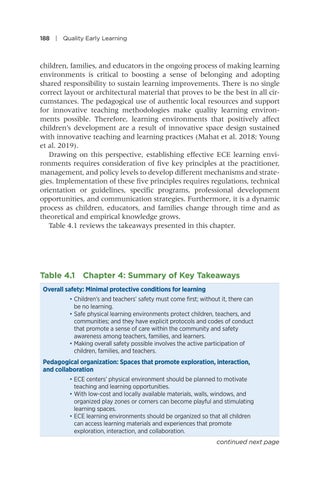188 | Quality Early Learning
children, families, and educators in the ongoing process of making learning environments is critical to boosting a sense of belonging and adopting shared responsibility to sustain learning improvements. There is no single correct layout or architectural material that proves to be the best in all circumstances. The pedagogical use of authentic local resources and support for innovative teaching methodologies make quality learning environments possible. Therefore, learning environments that positively affect children’s development are a result of innovative space design sustained with innovative teaching and learning practices (Mahat et al. 2018; Young et al. 2019). Drawing on this perspective, establishing effective ECE learning environments requires consideration of five key principles at the practitioner, management, and policy levels to develop different mechanisms and strategies. Implementation of these five principles requires regulations, technical orientation or guidelines, specific programs, professional development opportunities, and communication strategies. Furthermore, it is a dynamic process as children, educators, and families change through time and as theoretical and empirical knowledge grows. Table 4.1 reviews the takeaways presented in this chapter.
Table 4.1 C hapter 4: Summary of Key Takeaways Overall safety: Minimal protective conditions for learning • Children’s and teachers’ safety must come first; without it, there can be no learning. • Safe physical learning environments protect children, teachers, and communities; and they have explicit protocols and codes of conduct that promote a sense of care within the community and safety awareness among teachers, families, and learners. • Making overall safety possible involves the active participation of children, families, and teachers.
Pedagogical organization: Spaces that promote exploration, interaction, and collaboration • ECE centers’ physical environment should be planned to motivate teaching and learning opportunities. • With low-cost and locally available materials, walls, windows, and organized play zones or corners can become playful and stimulating learning spaces. • ECE learning environments should be organized so that all children can access learning materials and experiences that promote exploration, interaction, and collaboration. continued next page




